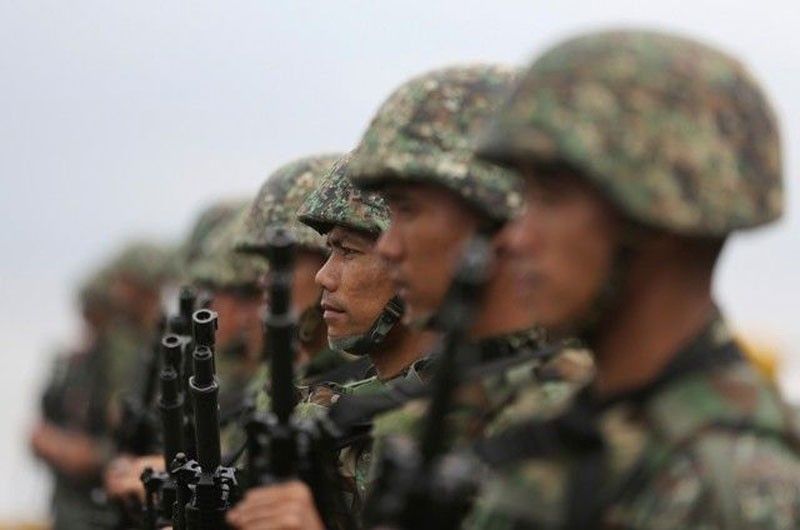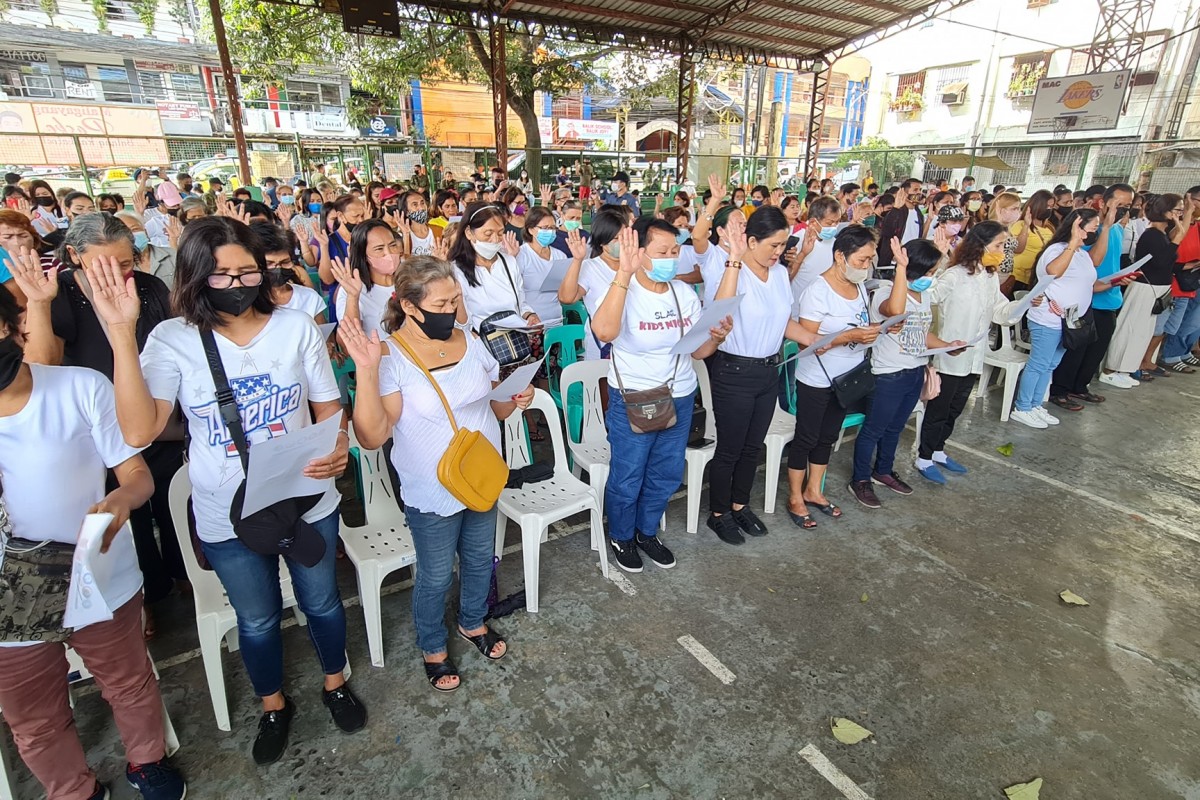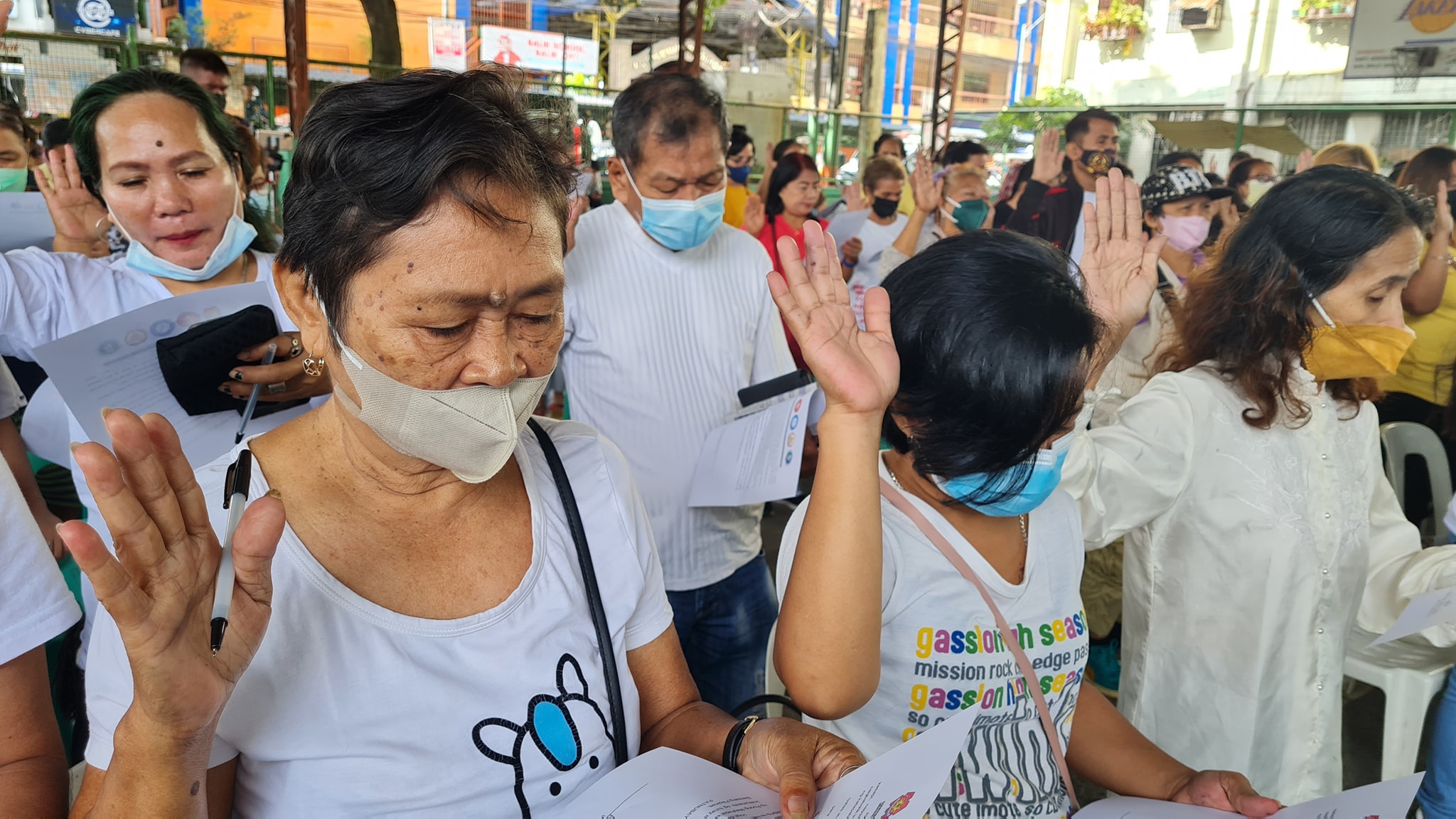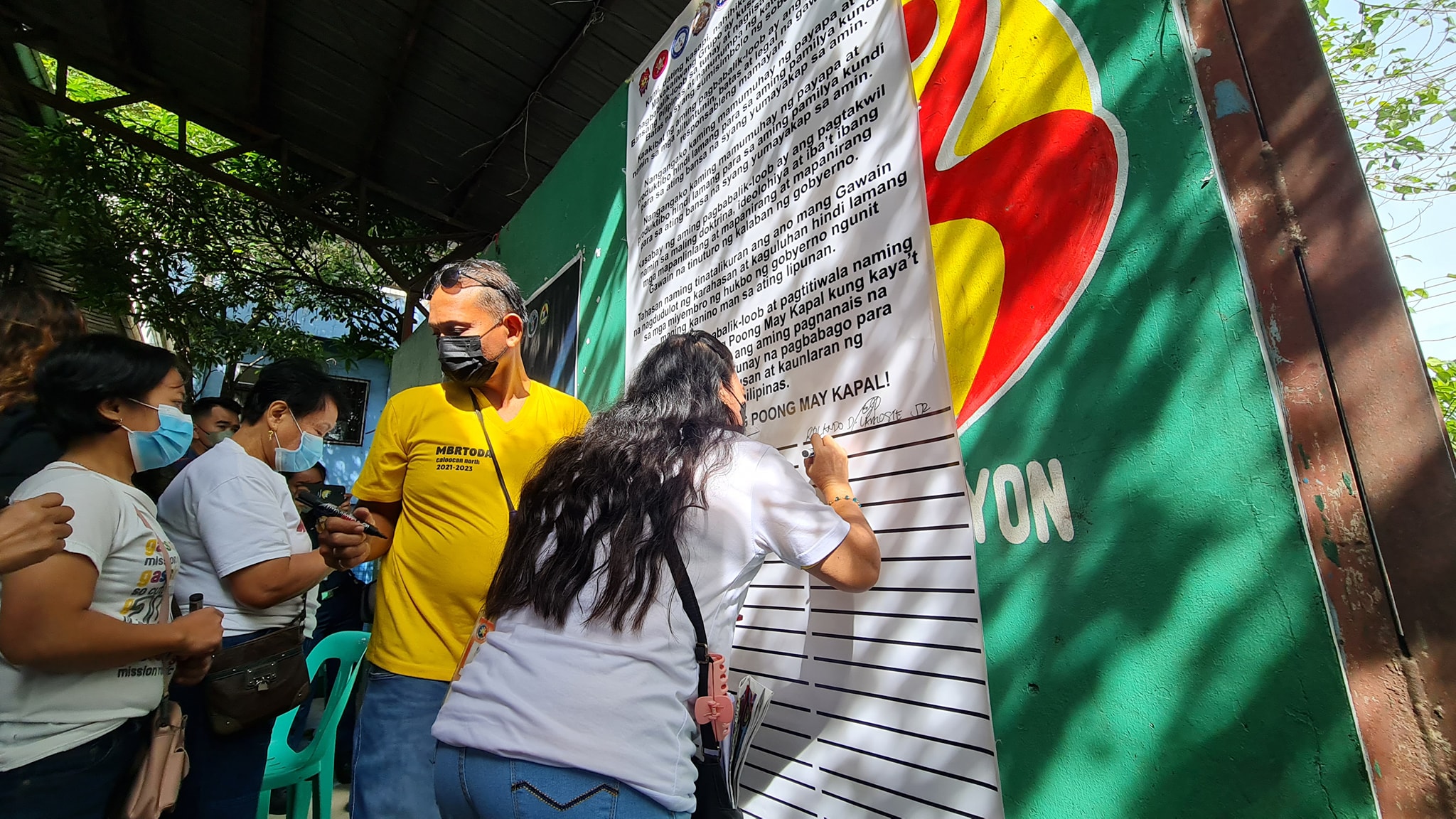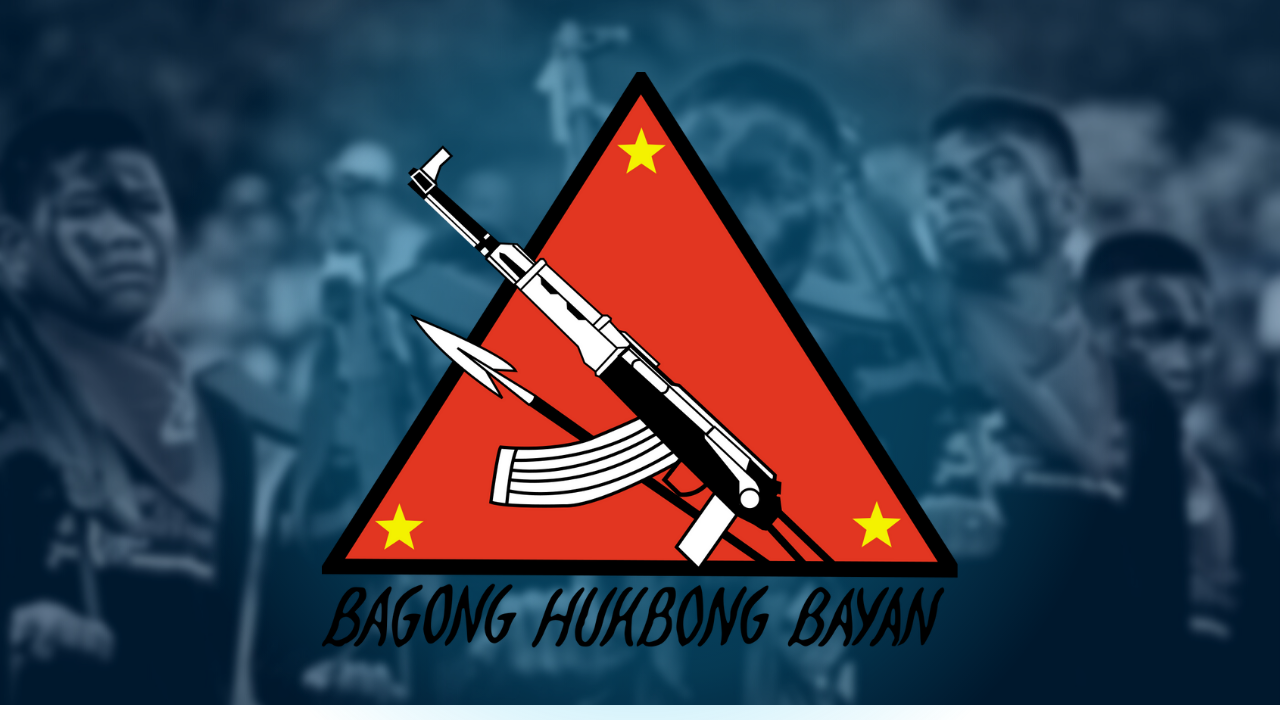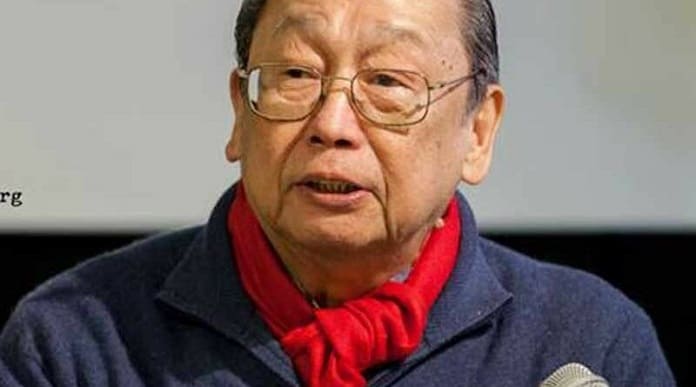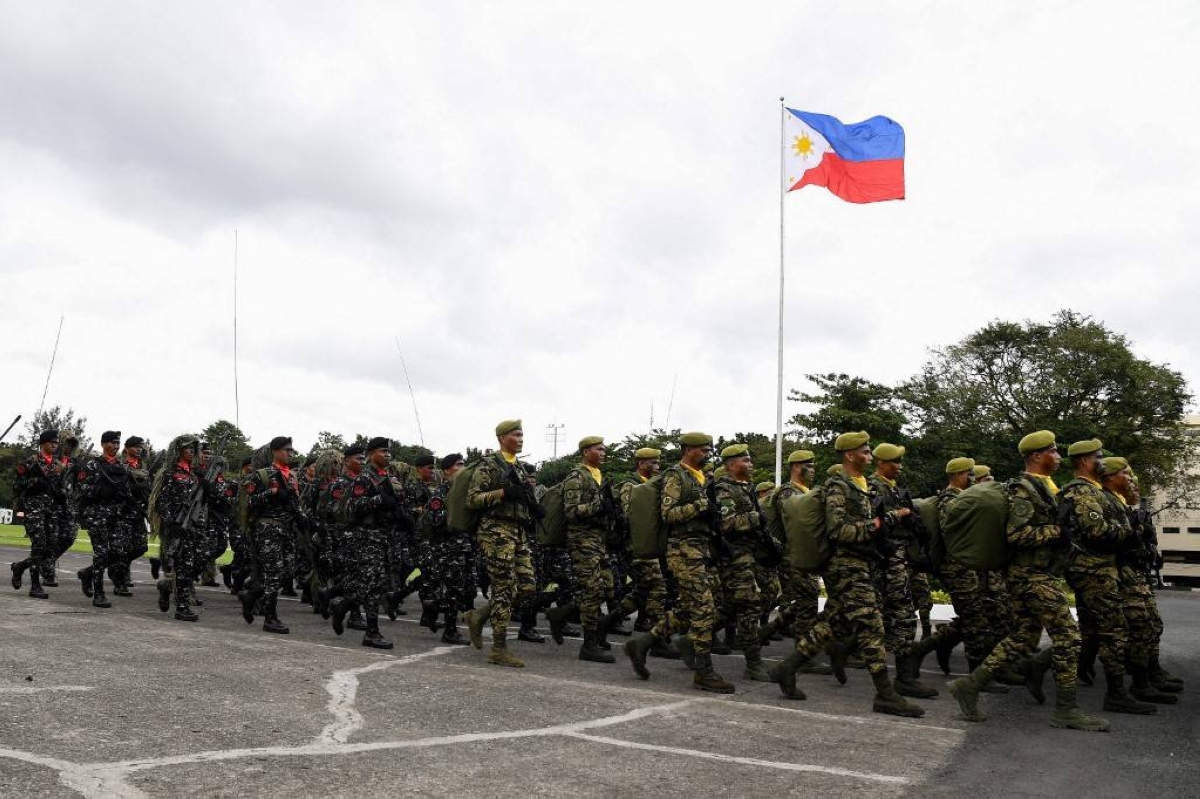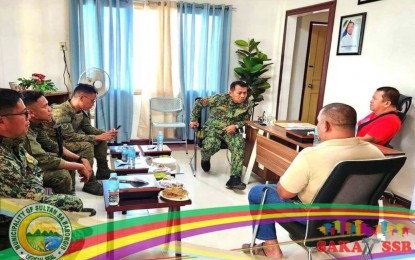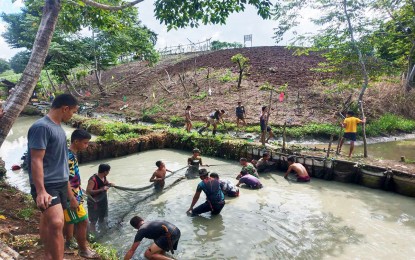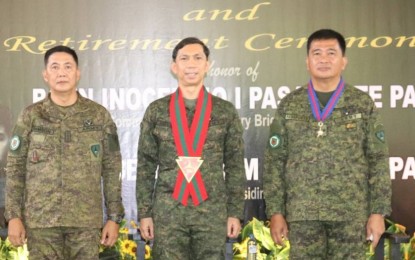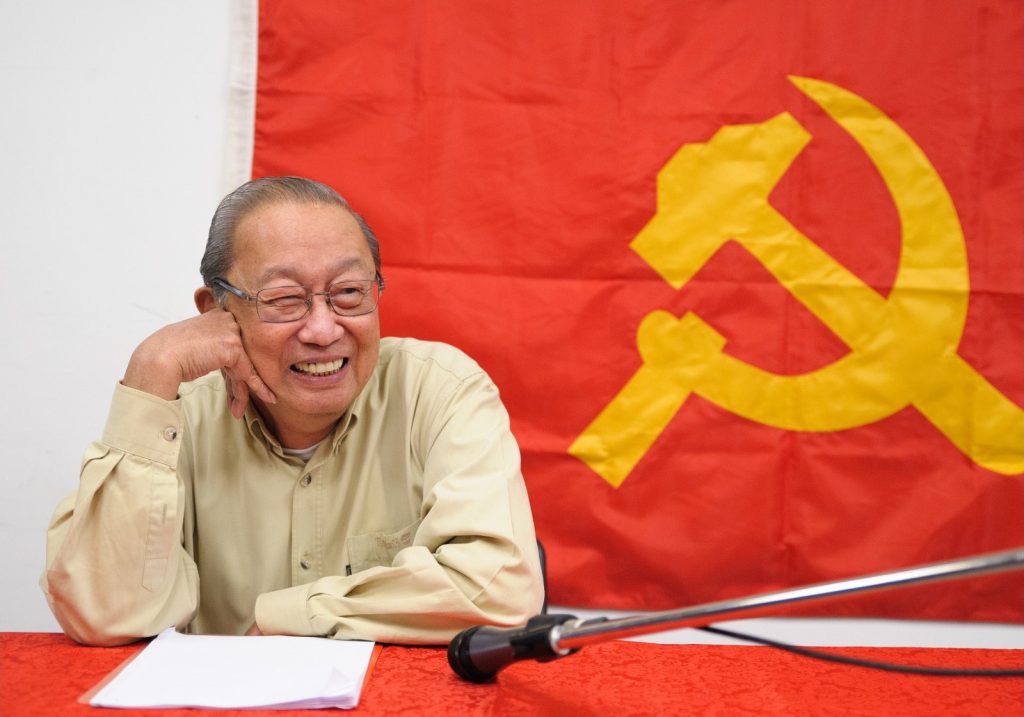Propaganda statement posted to the Communist Party of the Philippines (CPP) Philippine Revolution Web Central (PRWC) Website (Dec 23, 2022):
Jose Maria Sison's Valedictory Message to the Party and Filipino peopleThe Filipino People’s Democratic Revolution Is InvincibleFounding Chairperson
Communist Party of the Philippines
December 23, 2022
It is with deepest grief that I have to be the one to issue my husband’s last and final message to the revolutionary forces and the people on the 54th anniversary of the Communist Party of the Philippines. He started discussing with me the outline and writing of the message a few days a month ago when he just got discharged from the hospital at his second confinement in November and just before the start of his third and last confinement on November 28. He wrote the first draft on paper, which I keyed in to the computer and then he reread and corrected it twice to produce this final draft below.
Some fifteen or so minutes before Joma took his last breath, he we was still talking about ensuring the revolution would win victory and advancing to socialism. With his last thoughts he remained optimistic about the Filipino people whom he served with utmost determination.
—Editor
_______________________________________
The Filipino People’s Democratic Revolution Is Invincible
Jose Maria Sison, Founding Chairman
Communist Party of the Philippines
December 26, 2022
Since after the reestablishment of Communist Party of the Philippines on December 26, 1968 and the prompt founding of the New People’s Army on March 29, 1969, every reactionary regime of the semicolonial and semifeudal ruling system in the Philippines (from the time of Ferdinand Marcos, Sr. to the present) has adopted and implemented a strategic operational plan to destroy the Filipino people’s democratic revolution.
But each strategic ‘oplan’ has always utterly failed and instead resulted in the significant growth of the revolutionary movement. Marcos went to the extent of imposing a fascist dictatorship on the people from 1972 to 1986 on the pretext of suppressing the CPP and armed revolution, “save the republic and build a new society”. But his power grab merely stimulated and accelerated the all-round growth of the revolutionary movement nationwide. Ultimately, the armed revolution inspired and backed up the people’s mass uprisings in Metro Manila and nationwide in order to remove the fascist dictatorship from power.
The pseudo-liberal democratic regimes that followed the Marcos fascist dictatorship tried to combine their respective military strategic ‘oplans’ with tactics of deception, including offers of prolonged ceasefire and peace negotiations without addressing the roots of the armed conflict or civil war. Every reactionary regime has been obsessed with destroying the revolutionary movement and preserving the unjust ruling system of oppression and exploitation.
It has used the anti-terrorist card anytime to delay, suspend or terminate the peace negotiations, despite such major joint agreements between the Government of the Republic of the Philippines and the National Democratic Front of the Philippines as The Hague Joint Declaration of 1992 as framework for peace negotiations and the Comprehensive Agreement on Respect for Human Rights and International Humanitarian Law of 1998.
Despite the peace negotiations, every reactionary regime has taken the liberty of killing cadres and members of the revolutionary movement. When the NPA captured General Obillo of the reactionary armed forces under the terms of the CARHRIHL and international laws in 1998, it immediately announced willingness to release him as a prisoner of war upon agreement on the safe procedure for his release. But Estrada continuously took offense and used the capture of his general to become the first reactionary president to terminate the peace negotiations in May 1999.
After his overthrow by people’s mass uprisings in 2001, the Arroyo regime agreed to resume the peace negotiations in 2002, with the Royal Norwegian Government as the third-party facilitator. But in 2004 it became obvious that the Arroyo regime was following US dictates to slow down the negotiations on substantive issues and to suspend them indefinitely and unleash bigger military operations in the name of the “whole-of-nation approach”. These military operations failed utterly to destroy the people’s war. The rabid anti-communist defense secretary would eventually commit suicide upon exposure of his corruption in the handling of the military budget and even of the retirement funds of AFP officers and personnel.
I. Complete sabotage of the GRP-NDFP peace negotiations
But the worst came when Duterte became president. He pretended to be eager to conduct peace negotiations but he carried out an all-out war policy against the revolutionary movement by extending Aquino’s Oplan Bayanihan until January 2017 when Oplan Kapayapaan was adopted and implemented. Instead of joining the NDFP in addressing the roots of the civil war through basic social, economic and political reforms, he concentrated on trivial and puerile tactics calculated to push the revolutionary movement to capitulation by demanding that the people’s democratic government give up its legitimate powers, offering CPP representation in his cabinet prior to a peace agreement and then self-contradictorily including the NPA as target of his martial law proclamation against the Maute group in Mindanao in 2017.
Failing to achieve his short-sighted objectives in trying outwit the NDFP, Duterte agreed with his military minions to stop serious peace negotiations with the NDFP by hyping fake “localized peace talks” under the surveillance and control of the GRP. Duterte and AFP officers became obsessed with increasing the military budget to accommodate their insatiable appetite for corruption and the operations to red-tag, intimidate people and abduct, detain, torture and murder their political opponents. Thus, the ground was laid for the termination of the GRP-NDFP peace negotiations on November 23, 2017 by Duterte after openly consulting US President Trump.
The Duterte’s termination of the peace negotiations since 2017 was intended not only as a negotiating trick but as the beginning of ending permanently the peace negotiations. Subsequently, Duterte designated and proscribed the CPP and NPA on December 5, 2017 and ultimately the NDFP on the same grounds, created the National Task Force to Eliminate the Communist Local Armed Conflict (NTF-Elcac) and took advantage of the Covid-19 pandemic to railroad the Anti-Terror Law (ATL) in the servile Congress and the creation of the Anti-Terrorism Council to put the Philippine once more under state terrorism or fascist dictatorship, violate the national and democratic right of the people with impunity and allow those in power to commit treason, tyranny and thievery.
Within this anti-national and anti-democratic framework, Duterte has passed on the reactionary government and ruling system to the Marcos Junior-Sara Duterte tandem by completely controlling the automated electoral system and fabricating more than 20 million votes in favor of the tandem and its candidates for Congress and local executive positions. The current de facto Marcos-Duterte regime is under the dictates of US imperialism and the big comprador-bureaucrat interests of the Marcos and Duterte dynasties and will condone and continue the monstrous crimes of the previous regime until the opposition forces, the revolutionary movement and the broad masses of the people can act to change the situation in the Philippines.
In the meantime, the Filipino people have to suffer the rising level of oppression and exploitation due to the worsening chronic crisis of the ruling system and the anti-national and anti-democratic policies of the Marcos-Duterte tandem. Day after day, they have to suffer, defy and fight not only the bloody human rights violations but also the fake news in the psywar campaign of those in power that the Filipino people and their revolutionary forces have given up the revolutionary struggle for national liberation and democracy.
It is absolutely untrue that the people’s revolutionary forces are dwindling and being defeated and that the Red cadres, commanders and fighters–all tested and tempered in more than 54 years of victorious people’s war—are rapidly being killed or captured in focused military operations or surrendering because of such band-aid offers like the graft-laden Enhanced-Comprehensive Local Integration Program, Community Support Program and Barangay Development Plan. And yet the ruling clique and its military minions keep on demanding more public funds not only to attack the people but also to pocket the larger part of the military budget.
The reactionary armed forces have in fact officially admitted that the NPA grew in strength during the Duterte regime. Towards the end of the Aquino II regime in January 2016, when they claimed the success of Oplan Bayanihan, they announced that the NPA commanders and fighters have been reduced to only 3,900. Now, they claim that at the end of the Duterte regime that they have caused the surrender of nearly 24,000 Red fighters. Unwittingly, they expose themselves as big liars and and big budget thieves and admit that the NPA actually increased its strength during the Duterte regime.
II. Why the people’s democratic revolution is invincible
The Filipino people’s democratic revolution is invincible because it is just and necessary to fight for and achieve national liberation and democracy against the three evil forces of foreign monopoly capitalism, domestic feudalism and bureaucrat capitalism in a rapidly rotting semi-colonial and semifeudal society. This new democratic revolution is a continuation of the old democratic revolution that was started in 1896 by the Katipunan and was victorious against Spanish colonial rule but was defeated by the US war of aggression that started in 1898. This time, the leading class in the revolution is no longer the liberal bourgeoisie but the proletariat in the era of modern imperialism and proletarian revolution.
So long as the aforesaid three evil forces dominate and afflict the Filipino nation, the ground remains fertile for the growth and advance of the people’s democratic revolution. The chronic crisis of the ruling system has been worsening not only due to the factors of exploitation and oppression within the Philippines but due to those in the world capitalist system, chiefly US monopoly capitalism. The Philippines is fortunate to have rich natural resources for its own development but unfortunately the imperialist powers and their reactionary puppets have always agreed to exploit the cheap labor of the toiling masses of workers and peasants and the abundant natural resources of the people.
At every major shift of its economic policy in East Asia, US imperialism has always made it a point to prevent the economic development through a program of genuine land reform and national industrialization in the Philippines. We have seen such phenomenon in the periods when the US favored Japan’s economic reconstruction and expansion after World War II and the economic growth of the “economic tigers” to serve as anti-communist front liners during the Cold War and when it promoted neoliberalism and fascism and developed a neoliberal partnership with China until their ongoing decoupling and intensified economic competition and political rivalry.
In the course of its closest neoliberal partnership with China, the US and its chief Filipino puppets encouraged and allowed China to encroach on the West Philippine Sea in order to have the pretext for the US to circumvent the constitutional prohibition against foreign military bases and forces in the Philippines by making the Enhanced Defense Cooperation Agreement to allow the US military forces to have exclusive bases and facilities within the camps and military reserve areas of the reactionary armed forces. But now, the US is conspicuously locked in a contest with China to plunder the natural resources of the Philippines and the rest of ASEAN.
China is more than ever hell-bent on keeping its artificial and militarized islands in the West Philippine Sea because its own undersea explorations show that there are at least USD 26.3 trillion of gas, far more than enough to carry out genuine land reform and industrialize the Philippines and thereby fulfill the main socio-economic demand in the GRP-NDFP peace negotiations. Despite all its pious and glittering generalities for helping the ASEAN develop and for starting its reduction of carbon emissions by 2030, China is determined to grab the gas, marine and other natural resources of the Filipino people in the West Philippine Sea.
The Philippine economy and government are bankrupt due to its internal ills and the unprecedented crisis of the world capitalist system. Due mainly to extreme corruption, import-dependent consumption and military overspending, the Duterte regime has more than doubled in only six years to Php 12.5 trillion the Philippine public debt of Php 5.9 trillion which had been accumulated since 1902. He did a favor to Marcos Jr. by making him president through the fabrication of more than 20 million votes in the last elections but he has given him the big problem of looking for Php 1.6 trillion to pay for amortization and interest payments to support the Php 5.2 trillion budget for 2023.
The Philippine is now reeling from severe conditions of economic depression, decreased export of raw materials and labor, lessened tax revenues and tighter international credit. Production and employment have fallen so steeply. There is severe decline in food production, including rice, vegetable and fish, and inflation is soaring. But the Marcos-Duterte ruling team circulate the painful joke that the people can always buy imported food, despite the big drop in earnings from the export of raw materials and cheap labor.
The Filipino people are outraged that the two worst political dynasties (Marcoses and Dutertes) rule the Philippines, have no solution to the urgent basic problems of the people, but engage in the most scandalous forms of corruption (e.g. unaudited confidential and intelligence funds) and in the increase of the military budget to intimidate the people and suppress mass resistance despite the psywar claims that the revolutionary forces have been destroyed or their actual strength reduced to only five guerrilla fronts nationwide.
III. The armed counterrevolution will continue to fail
The armed counterrevolution being waged by the Marcos-Duterte ruling combine will continue to fail because the objective conditions of the rapidly worsening crisis of the ruling system are making it impossible for the ruling classes of big compradors and landlords and their bureaucrats to rule in the old way (be it the pseudo-liberal or fascist way); and because it is actually the subjective forces of the revolutionary movement and the broad mases of the people that are gaining strength and advancing the new democratic revolution under the class leadership of the proletariat and along the general line of protracted people’s war
As the advanced detachment of the proletariat, the CPP has made great achievements in its ideological, political and organizational work. It has been guided by the theory and practice of Marxism-Leninism-Maoism and has applied it on the history and current social circumstances of the Filipino people, It has put forward the general line of people’s democratic revolution with the strategic line of protracted people’s war and with the socialist perspective. It has upheld the principle of democratic centralism and has built a nationwide organization that is well integrated with the toiling masses of workers and peasants and the rest of the people.
There is no way that the reactionary state can stop the few CPP cadres from performing their tasks in ideological work. From year to year and from decade to decade, under the auspices of the Revolutionary School of Mao Zedong Thought, they were able to educate more Party cadres and members in the course of mass work and put them through the basic, intermediate and advanced levels of Party education after they take the revolutionary mass course for mass activists.
Revolutionary studies can be carried out in so many ways far beyond the limited capabilities of the enemy to spy on and the study materials are now widely available in hard and soft copies.
In their struggle for national and social liberation, the Filipino people regard the CPP as the most important revolutionary weapon responsible for leading the peoples democratic revolution. In turn, the CPP wields two other powerful weapons, armed struggle and the united front (constituted as the New People’s Army and the National Democratic Front of the Philippines, respectively). The NPA is the main force for fighting and defeating the coercive apparatuses of the reactionary state and enabling the rise of the people’s democratic government. The NDFP is responsible for building the comprehensive national united front and winning over the people in their tens of millions to the revolution against the armed counterrevolution.
The NPA carries out the strategic line of protracted people’s war of encircling the cities from the countryside. In a semicolonial and semifeudal country like the Philippines, the countryside provides for the widest possible social and physical terrain and area of maneuver for developing the strength of the people’s army through definite strategic stages, such as the defensive, the stalemate and counter-offensive. Most of the people are in the countryside. And the main democratic content of the peasant masses is agrarian revolution, the satisfaction of the democratic demand for land.
The NPA is tasked to wage armed struggle as the main form of struggle, carry out genuine land reform from the minimum to the maximum stage and build the revolutionary mass base. It has a major role in building the mass organizations and the organs of political of power that constitute the people’s democratic government and carrying out mass campaigns, programs and activities that implement mass education and organization, land reform and socio-economic development, self-defense, settlement of disputes, protection of the environment and other important tasks.
In accordance with the strategic defensive stage, the NPA been victorious in carrying out the people’s war through guerrilla warfare on the basis of an ever widening and deepening mass base. This has allowed the NPA to build the guerilla fronts initially in a few areas and regions and eventually to the eleven major islands inhabited by 94 per cent of the people. Now, the NPA operates in 74 out of the 82 Philippine provinces and enjoys the support of the Filipino people and by the NDFP in all the Philippine provinces.
Every reactionary regime has boasted of being able to destroy the armed revolution within the current term of whoever is the president. But the semicolonial and semifeudal character of the ruling system and its ever-worsening chronic crisis put limits on its ability to control the population and suppress the people’s resistance. At any given time, the NPA and other revolutionary forces can work freely and launch tactical offensives in more than 80 per cent of the Philippine archipelago.
Of course, the reactionary armed forces and police can do their best to identify and target the NPA guerrilla fronts with focused or concentrated military campaigns. But the strategy and tactics of guerrilla warfare have served the NPA very well. When the enemy advances in superior force, the NPA main force retreats but deploys command-detonated land mines and sniper teams against the advancing enemy. When the enemy displaces and occupies the area of an NPA guerrilla front, the NPA surveils the enemy deployment in order to be able to know how to harass the enemy camp, hit the isolated perimeter guards and ambush the patrol units.
When the encamped enemy tires out and retreats, it is the turn of the NPA to make the advance and deliver more offensive blows. But even while the enemy seems to have the upper hand through his advance and encampment, the NPA force on tactical retreat in one guerrilla front can initiate tactical offensives that it can win in a nearby area. Worst of all for the enemy, as has been often the case, in so many other guerrilla fronts in the same region and all other regions the NPA take the initiative to launch tactical offensives by way of strengthening themselves through struggle and helping the guerilla fronts under focused or concentrated enemy attacks.
On the whole in its entire history, the CPP has been excellent and successful in building the nationwide strength of the revolutionary forces by being able to lead and coordinate them in various forms of struggle and, in the field of revolutionary armed struggle, using an existing guerrilla front to beget other guerilla fronts in the same region and provide experienced CPP cadres and NPA commanders and fighters to other regions.
The initial guerrilla front in Tarlac in 1969 led to the building of several guerrilla fronts in Central, Northern and Southern Luzon from 1969 to 1971 and the big wave of CPP-NPA expansion teams to the Visayas and Mindanao from 1972 onwards. Then within the same decade of the 1970s, the guerrilla fronts of the Visayas and Mindanao helped each other and also provided experienced CPP cadres and Red commanders to Luzon. The CPP, NPA and NDFP have become so well-rooted on a nationwide scale and well-integrated with the toiling masses of workers and peasants and the rest of the people.
IV. Perspective of the people’s democratic revolution
The people’s war in the Philippines is still at the stage of the strategic defensive, advancing from the middle phase to the advanced phase. In concrete terms, nationwide guerrilla warfare is the main form of armed struggle being carried out nationwide. At the same time, NPA companies have arisen from the platoons in preparation for the completion of the strategic defensive and advance to the strategic stalemate wherein companies and battalions will have increasing role in tactical offensives.
The strategic stalemate will probably be shorter than the already protracted strategic defensive with the NPA companies and battalions. Such forces already in stable base areas can be regrouped regiments and battalions in an even shorter time for the strategic counteroffensives to capture or compel the surrender of the last and most fortified and isolated holdouts of the enemy. This is merely a line of probability based of successful civil wars. But there is always the contrary line of probability that US imperialism launches a war of aggression against the people before the Philippine revolution.
The reactionary Marcos-Duterte tandem is hell-bent on continuing the armed counter-revolution to preserve the ruling system, serve the interests of US imperialism and let the current civil war pave the way for a US war of aggression. The Filipino people have no choice but to carry out the new democratic revolution by continuing the protracted people’s war against not only the reactionary state in the current civil war but also the rising military intervention and probable war of aggression by US imperialism.
But there are growing limits to what the US can do to dominate the Philippines, East Asia and the world. It is still No. 1 imperialist power but it is on a strategic decline from its peak after a period of enjoying the status of being sole superpower after the 1991 collapse the Soviet Union, partnering with China in “neoliberal” globalization, expanding the NATO, launching wars of aggression under the so-called neoconservative policy and wasting the enormous amount of USD 10 trillion without any significant increase of territory for exploitation.
The limits of US imperialist power have been exposed by its failure to take over the oil resources and build 16 military bases in Iraq, to destroy the Syria-Russia-Iran alliance, to break the revolutionary struggle of the Turkish and Kurdish people and to hold on to Afghanistan surrendering it to the Taliban. In the current Russian-Ukraine conflict, the US has been using Ukraine as proxy to threaten and provoke Russia to launch a war but conflict has merely served both Russian and US imperialism to waste resources. It has led even the NATO allies of the US to complain why they have to spend more money for energy supply from the US than for the cheap gas from the Russians.
Despite the recent hype that the US can wage to its advantage a war of aggression against China, DPRK and Russia, the people must be reminded that the US lost the Asian mainland and Eurasia as early as the 20th century after losing a series of wars. The drive of US imperialism for wars of aggression and the danger of world war and nuclear war is still restrained by the fear of mutual annihilation and human extinction on the part of the US and all other nuclear powers. Global warming appears to be more imminent as a threat to human existence than nuclear war.
The crisis of the world capitalist system is rapidly worsening due to the over-accumulation of monopoly capital and over-extraction of surplus value from the toiling masses and the intelligentsia. All major contradiction are intensifying such as those between labor and capital, between the imperialist powers themselves, between the imperialist powers and the oppressed peoples and nations and between the imperialist power and the countries assertive of national independence and desirous of democracy and socialism.
The 2008 financial meltdown has developed into a global depression far more prolonged and severe than the Great Depression of the 1930s, which led to the rise of fascism and World War II. But in the meantime, there are still the UN and multilateral and bilateral relations of states among both the main imperialist contenders and third world countries that uphold their own national sovereignty and their own interest in peace and development and wish to fight fascism and imperialist war.
It is the toiling masses and the rest of the people who fight for national liberation, democracy and socialism against imperialism and all reaction who let us hope for a bright future of world peace and common prosperity. They are now waging anti-imperialist and democratic mass struggle against the current global crisis that has been brought about by revisionist betrayal of socialism, neoliberalism and fascism. These are the prelude to the resurgence of the world proletarian-socialist revolution.
https://philippinerevolution.nu/statements/the-filipino-peoples-democratic-revolution-is-invincible/
